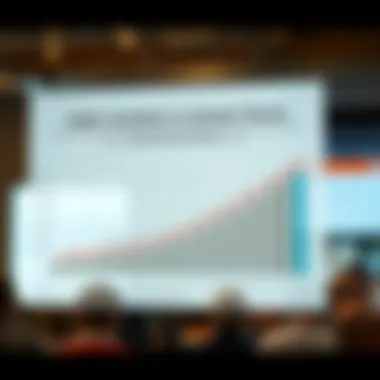Examining the Possibility of Another Federal Stimulus Check


Intro
As the economic landscape continues to shift like sand underfoot, the notion of another federal stimulus check hangs in the air like an unspoken promise. With inflation gnawing at household budgets and various sectors still feeling the aftershocks of recent crises, the question arises: is further government assistance not just a possibility, but a necessity?
This in-depth examination aims to unpack the complexity surrounding potential future stimulus payments. By analyzing various indicators, expert opinions, and public sentiment, we’ll navigate the winding path of economic policies and public needs.
A significant aspect of this discussion is the interplay among economic indicators, such as unemployment rates and consumer spending patterns. They not only signal the state of the economy but also directly influence governmental decisions on fiscal stimulus measures. Moreover, historical examples serve as valuable lessons; past stimulus checks demonstrate how timely financial infusions can act as lifelines in turbulent economic waters.
The anticipation is palpable as we delve deeper into the implications of a potential check. If you’re an investor or merely trying to make ends meet, understanding the nuances of this subject is crucial. Buckle up, as we sift through the layers of fiscal policy and public sentiment surrounding the prospects of a new stimulus check.
Prelims to Federal Stimulus Checks
The discussion surrounding federal stimulus checks is not just a matter of numbers; it's about communities, economies, and the lifeblood of families and businesses. As we stand amidst shifting economic landscapes and grappling with inflationary pressures, the relevance of these checks takes on heightened significance. This article aims to dissect these monetary maneuvers initiated by the government, delving into their implications, intricacies, and effectiveness in stabilizing the economy and aiding citizens. Understanding federal stimulus checks is crucial, as they serve as a lifeline for many during turbulent times, impacting spending habits, savings, and overall economic stability.
Defining Federal Stimulus Checks
At their core, federal stimulus checks are direct payments from the government to individuals or households. They are designed to stimulate economic activity, provide immediate financial relief, and encourage spending. These checks can take various forms, such as one-time payments, monthly disbursements, or tax rebates, depending on legislative decisions.
For example, the Economic Impact Payments during the COVID-19 pandemic were structured as direct financial aid aimed at promoting household spending. The idea is straightforward: the government allocates funds to help citizens meet their basic needs and reinvigorate the economy.
Historical Context
To grasp the current landscape of stimulus checks, it’s essential to reflect on their historical context. The concept isn't novel; federal stimulus checks have a history that traces back to various economic crises. A notable instance occurred during the Great Recession of 2008-2009 when the American Recovery and Reinvestment Act was put into effect. The government directed substantial funds toward various programs, aiming to prop up the struggling economy and encourage investments.
Fast forward to the pandemic, and we saw a seismic shift in the approach to stimulus checks. Rather than just addressing economic downturns, the checks were seen as necessary tools to combat the immediate fallout from lockdowns and business closures.
Throughout history, these payments have evolved, influenced by key economic indicators and public sentiment. Different eras exhibit varied approaches based on political landscapes and economic theories. This context is crucial for understanding the motivations behind the possible issuance of further checks today.
Factors Influencing Another Stimulus Check
The discussion surrounding the possibility of another federal stimulus check is deeply intertwined with various economic factors. Understanding these elements is vital for grasping the current landscape of potential government relief measures. Key factors include current economic indicators, unemployment rates, and inflation trends, each of which serves as a fundamental piece in this puzzle. Knowing about them enables investors and financial enthusiasts to make informed decisions.
Current Economic Indicators
Economic indicators act like navigational stars in the complex world of finance. They help gauge the temperature of the economy, highlighting areas that need attention. For instance, metrics like GDP growth rate, consumer confidence index, and retail sales figures all play a significant role in understanding whether additional stimulus payments will make their way to households.
Recent figures show a fluctuating GDP, which raises eyebrows. Consumer spending has shown resilience, but it remains precarious. This duality could push policymakers to consider another round of stimulus to ensure sustained economic momentum.
- GDP Fluctuations: A GDP that refuses to stabilize can prompt discussions regarding a fresh infusion of cash to boost spending.
- Consumer Confidence: When confidence wanes, the likelihood of governmental relief increases.
- Retail Sales: If retail sales take a nosedive, we may see proactive measures such as stimulus checks.
Understanding these indicators sheds light on the government's potential motivations. If the indicators paint a grim picture, expect lawmakers to rally for stimulus discussions.
Unemployment Rates and Job Growth
Joblessness can have a chilling effect on consumer behavior. When people are without work, spending plummets, creating a ripple effect that affects the entire economy. Therefore, tracking unemployment rates and job growth offers insights into the urgency for another stimulus check.
While recent statistics have shown some recovery in job creation, not all sectors are equally buoyant. The gig economy, for instance, has encountered turbulence that traditional metrics may overlook.
Consider the following points:
- Long-Term Unemployment: Those who remain jobless for extended periods can represent a demographic desperate for support.
- Sector-Specific Recovery: Certain industries might lag, making them ripe for targeted government aid.
- Job Creation Rates: Consistent growth in job opportunities generally reduces the chances of additional checks needed.
If job growth experiences stagnation, calls for another stimulus package may grow louder as officials look to protect consumers from economic despair.
Inflation Trends
Inflation serves as a double-edged sword. On one hand, moderate inflation can indicate a growing economy. On the other, unchecked inflation can erode purchasing power, making life harder for everyday people. Monitoring inflation trends is, therefore, essential not only for predicting the potential for additional stimulus checks but also for understanding how those checks might adjust given the current financial climate.


A soaring inflation rate could prompt the government to distribute checks in an effort to alleviate some burdens. However, such measures might also mean adjusting the amount disbursed. Here are a few key aspects to consider:
- Cost of Living Adjustments: Rising prices might necessitate larger checks.
- Consumer Behavior Changes: People may alter their spending habits in response to inflation, impacting overall economic recovery.
- Interest Rate Adjustments: The Federal Reserve could play a key role in influencing the conditions under which another check would be issued.
In sum, the interplay among these economic signs paints a complex picture that must be navigated carefully by policymakers. Should inflation remain unchecked, additional stimulus could become a necessary evil in the efforts to stabilize and stimulate the economy.
In a highly interconnected economy, each factor woven together tells a greater story—one of recovery or decline dependent on rapid movements in the market. As such, those who wish to stay ahead must pay close attention to these influencing elements.
Political Landscape and Stimulus Packages
The political landscape surrounding stimulus packages is a pivotal aspect of understanding whether additional federal stimulus checks will materialize. The intersection of policy decisions, political ideologies, and public pressures plays a significant role in shaping the discourse on economic relief measures. As history demonstrates, the decisions taken by legislators often reflect the collective mood and needs of their constituents, making this analysis not only relevant but crucial for comprehending potential future actions.
Bipartisan Support and Challenges
Traditionally, stimulus packages have found support across party lines during times of crisis. However, achieving bipartisan consensus isn't just a cakewalk. The tension often arises over differing ideologies regarding the extent and nature of government intervention in the economy.
- Support Factors:
- Challenges Faced:
- Economic Necessity: Amid deteriorating economic conditions, both parties are compelled to acknowledge the need for relief, particularly when public distress peaks.
- Electoral Considerations: With elections knocking on the door, politicians frequently align their positions with the desires of the electorate to secure votes.
- Partisan Divides: Issues such as the balance between fiscal responsibility and social safety nets create rifts. \n - Policy Differences: Each side may propose measures that reflect their core values. For example, strict fiscal hawks may advocate for limited checks, while progressives might push for expansive measures including higher payments.
"The debate over stimulus checks often becomes a microcosm of larger ideological battles within American politics."
Recent Legislative Actions
Recent legislative actions offer a glimpse into how negotiations unfold, reflecting priorities and adaptations in response to shifting economic landscapes.
- Passed Legislation: In recent months, lawmakers have introduced various relief packages, focusing primarily on infrastructure, healthcare, and employment. These indirectly influence discussions on direct financial relief, establishing a framework for future checks.
- Proposed Initiatives: Several bills aimed at revitalizing economic support for struggling families and small businesses, such as the Families First Coronavirus Response Act, have stirred debates. Even if they fall short of direct stimulus checks, these measures pave the way for future discussions on stimulus payments.
- Public Sentiment and Influences: With rising inflation and economic uncertainty, the pressure from constituents has prompted legislators to revisit previously stalled proposals. This heightened awareness of public sentiment trickles down into the legislative process, shaping negotiations.
Public Sentiment Towards Additional Government Aid
Understanding public sentiment around government aid is not just a side note; it’s a central theme in this whole discussion about stimulus checks. When citizens express their views, it carries weight that can influence policymakers one way or another. If a sizable portion of the public believes an additional stimulus package is necessary, lawmakers may feel pressured—like a feather on the scale—to act accordingly.
Surveys and Polling Data
Polling data acts as a snapshot of the public’s current mood. Recent surveys indicate that many Americans are still feeling the economic squeeze. For instance, a survey conducted by Gallup found that around 65% of respondents supported the idea of further direct financial assistance. This sentiment is often deep-rooted in personal experiences and economic realities.
Additionally, peer-reviewed studies suggest that demographic factors play a significant role in shaping opinions. For example:
- Younger adults often show higher support for stimulus checks, feeling the pinch due to rising costs in housing and education.
- Low-income families are more likely to see these payments as lifelines, voicing greater urgency for immediate support.
These surveys not only provide insights but also elevate the discussion on potential aid initiatives. With the data at hand, policymakers can better gauge how their decisions will resonate with voters.
Impact of Public Opinion on Policy Decisions
Public opinion doesn’t just sit there; it makes waves across the political landscape. When a substantial portion of voters demands extra support, elected officials might feel the heat to respond. For example, during the height of the pandemic, calls for stimulus checks were hard to ignore—much like an elephant in the room. Lawmakers found themselves navigating a tricky balance; responding to public demand while being mindful of economic implications.
Moreover, if polling indicates widespread dissatisfaction with current aid measures, it can push lawmakers to reconsider their stances.
- Political Strategy: Politicians who want to get re-elected often read the room well. If the tide shifts towards wanting more aid, these politicians might champion stimulus checks as part of their campaign platforms.
- Bipartisan Response: Often, politicians from both sides will unify if public sentiment strongly favors stimulus checks. It's a classic case of "the squeaky wheel gets the grease." Such unity can make it more feasible to pass legislation.
"Public opinion is the thermometer a politician reads when he needs to know the temperature of his constituency."
Understanding these dynamics—how sentiment shapes policy—helps clarify why gauging public sentiment is pivotal in this analysis about the potential for another federal stimulus check. As economic woes linger, the voices of the public will likely resonate louder than ever before.
Expert Opinions on Future Stimulus Checks


The question of whether there will be another federal stimulus check is not merely a matter of speculation; it hinges on the insights and analyses provided by economists and financial experts. Understanding expert opinions is crucial as it can shed light on the broader economic landscape that decision-makers must navigate. Without the guidance of seasoned professionals who dissect economic data, projections, and trends, it's difficult to gauge the viability and timing of potential relief packages.
Economic Theories and Predictions
Economic theories often serve as the backbone for understanding decisions surrounding stimulus checks. For instance, Keynesian economics advocates for government intervention in times of economic downturn, positing that increased public spending can drive demand and spur growth. Many experts echo this sentiment, arguing that another round of financial aid could indeed mitigate the impacts of ongoing inflation and job market instability.
Here’s an interesting viewpoint: some financial analysts suggest that direct payments might not be the panacea they were believed to be in earlier phases of the pandemic. This notion arises from the data showing that not all recipients spent their checks immediately. Instead, some saved or invested these funds, which doesn't directly translate into immediate economic stimulus. Thus, experts propose that future checks could be more effective if they are structured to encourage immediate spending—perhaps through vouchers for specific sectors heavily impacted by economic fluctuations.
Even though there’s a broad spectrum of predictions, economic models suggest that the likelihood of future checks largely rests on several variables, including:
- Current unemployment rates
- Inflation rates
- Consumer confidence levels
Understanding these variables can help investors make informed decisions.
Implications for Economic Recovery
The implications of potential stimulus checks on economic recovery are profound. Historically, stimulus payments have shown relatively quick impacts on consumer spending, which stimulates the economy. A surge in spending can mean a much-needed lifeline for struggling sectors, including retail and hospitality.
However, experts are divided on whether such measures would create sustainable growth or merely serve as a band-aid. There’s a real concern that excessive reliance on government aid might hinder natural market recovery, leaving consumers and businesses feeling disempowered. It's a classic case of balancing short-term relief with long-term economic health.
Furthermore, the ripple effects of stimulus payments extend beyond immediate financial relief. For example, increased cash flow can lead to heightened demand for goods and services, which in turn can drive job creation. Yet, this can also trigger inflationary pressures—a major factor in current discussions among economists.
As debates evolve, the collective insights of experts will undoubtedly play a pivotal role. Policymakers will need to listen and integrate findings from credible sources if they want to craft effective economic strategies. The road ahead relies heavily on understanding these nuanced economic narratives, especially for individual investors trying to anticipate market movements amid fluctuating economic signals.
"The best way to predict the future is to create it." – Peter Drucker.
In summary, expert opinions serve as a vital compass for navigating the complexities of another potential federal stimulus check. Economic theories and their implications for recovery are not just academic; they hold real-world significance, particularly for those invested in understanding the market's pulse.
Potential Demographics Impacted by Additional Payments
The topic of demographics that could benefit from additional stimulus payments serves as a crucial node in this broader discussion. Economic relief efforts often target specific groups, especially those who bear the brunt of financial fluctuations. Understanding who these demographics are not only aids policymakers in crafting effective responses but also informs individual investors seeking to gauge the potential impact of stimulus checks on market dynamics.
Low-Income Households
Low-income households represent a significant segment of the population that could be impacted by a new stimulus check. These families often operate on tight budgets, making them particularly sensitive to economic shocks. For them, an additional payment can be a lifeline. Such funds might go directly into covering essential expenses like groceries, rent, or utility bills.
Economic research indicates that individuals in lower income brackets tend to spend a higher percentage of any additional funds they receive. This behavior suggests that stimulus checks targeted at low-income households could lead to a swift boost in local economies, as these families are likely to spend their payments almost immediately. Therefore, in considering the potential benefits of a new federal stimulus, it's essential to highlight just how pivotal this demographic can be to economic recovery efforts.
Moreover, safety nets like stimulus payments may contribute to reducing poverty levels. During previous stimulus rounds, many low-income recipients reported decreased financial stress and improved overall well-being. That doesn't just benefit them but also contributes to broader societal stability. Without such financial support, individuals may face escalating debts, which could lead to long-term negative effects not only on their households but also on the economy at large.
Small Businesses and Entrepreneurs
Small businesses and entrepreneurs stand to gain significantly from additional stimulus payments as well. This demographic often includes various business owners who struggle during tough economic times. These are the folks running local cafes, boutiques, and service providers that form the backbone of the economy. In times of financial strain, many small businesses experience dips in revenue, making them vulnerable to closures.
Increased consumer spending, fueled by stimulus checks, can act as a well-needed booster shot for small enterprises. If low-income households receive additional funds, they are more likely to shop locally, thereby aiding entrepreneurs who depend on a steady stream of customers. This dynamic creates a positive feedback loop: as consumers spend more, businesses can maintain staff and avoid layoffs.
Furthermore, targeted support to small businesses can aid in their recovery and growth. Stimulus payments might enable these enterprises to invest in new opportunities, whether that’s upgrading technology, expanding service offerings, or even just keeping the lights on.
Policies designed with both low-income households and entrepreneurs in mind could forge a path toward more resilient local economies. Without such strategic thinking, the risk of prolonging economic downturns looms large.
Comparative Analysis of Previous Stimulus Checks
Understanding how previous stimulus checks functioned is paramount to grappling with the question of a new stimulus round. By examining their distribution mechanisms and the overall economic impact, we gain insights that could guide future policy decisions.
Distribution Mechanisms
Allocation methods for stimulus funds have varied significantly in past instances. The initial checks distributed during the COVID-19 pandemic were broadly targeted, with the CARES Act sending funds directly to qualifying individuals and families. This rapid approach ensured that aid flowed to those in dire need quickly.


In contrast, earlier checks, like those from the 2008 financial crisis, operated differently, focusing more on tax rebates and credits. For example:
- CARES Act (2020): Direct payments of $1,200 per individual, $2,400 for couples, plus $500 per child. Payments phased out at higher income levels.
- Economic Stimulus Act (2008): Tax rebate checks averaging $600 for individuals, adjusting based on tax returns.
Also notable are the administrative channels utilized. The IRS played a central role in delivering funds, while platforms like direct deposit, mailed checks, and even prepaid debit cards facilitated access. Each of these means has strengths and weaknesses that affect speed, efficiency, and accessibility. As the speed of financial relief can be the make-or-break factor for struggling families, understanding these mechanisms is key in evaluating future iterations.
Economic Impact Assessment
Evaluating the aftermath of past stimulus initiatives reveals a mixed bag of results. While these checks offered immediate financial relief, their longer-term economic ramifications are subject to debate. The 2020 stimulus checks provided crucial support during a time when many found themselves suddenly unemployed or underemployed. Reports indicated measurable increases in consumer spending in sectors like retail and dining shortly after these payments were received.
Following the Economic Stimulus Act, similar observations were noted, as even though it contributed to short-term spending boosts, some argue it fell short of spurring substantial long-term economic growth.
Key Considerations:
- Immediate Benefits: An uptick in consumer spending and business revenues post-payments.
- Long-Term Effects: Questions remain on whether such checks mitigate longer systemic issues or simply provide a temporary buffer.
Challenges and Risks of Additional Stimulus Checks
In navigating the contentious waters of federal stimulus checks, one must tread carefully, weighing benefits against the obstacles they may pose. While these checks undoubtedly offer immediate relief to many, they also carry with them the potential for significant economic ramifications. Understanding these challenges and risks is crucial for any thoughtful discussion surrounding future stimulus measures.
Inflationary Pressures
Inflation is a term that sends a shudder down the spine of many economists and policymakers alike. When additional stimulus checks are injected into the economy, there's a chance they may stoke the flames of inflation. At its core, when you pump more money into circulation, demand can outstrip supply, leading to price increases. This scenario isn’t mere speculation; it’s a reality faced during previous stimulus rounds.
For instance, the COVID-19 stimulus checks demonstrated that cash infusions can boost consumer spending immediately. However, along with that spending often comes an accompanying rise in prices, particularly for goods where supply chains are still recovering. Price spikes can be particularly hard on low-income households, the very targets the checks aim to assist.
- Key considerations about inflation include:
- The extent to which consumer spending increases can lead to rapid price upturns.
- Sectors most likely to feel the pinch, including food and housing.
- Potential long-term shifts in consumer behavior driven by changing prices.
"Cash in people's pockets tends to fuel demand, but if supply can't keep up, inflation isn't just possible; it's almost likely."
Impact on Federal Debt
Taking a close look at the impact on federal debt reveals another layer of complexity. Additional stimulus checks can potentially spiral into increased national debt levels. Funds need to come from somewhere, whether through increased borrowing or raised taxes down the road. This growing debt acts like a double-edged sword, helping in the short term but creating a looming threat for future generations.
The trade-off here is evident: immediate relief might come at the cost of long-term financial stability. Here are a few points to consider:
- Government debt concerns include:
- The sustainability of increased borrowing levels.
- Potential downgrades to the nation’s credit rating if debt levels remain unchecked.
- The burden increased debt places on future taxpayers.
As bold as the decision might be to send out more checks, policymakers must grapple with the long-term implications. Balancing urgent needs with fiscal responsibility is no easy feat. An honest dialogue around these challenges is essential if we are to guide the conversation towards substantiated economic recovery.
Ending: The Future of Federal Stimulus Checks
As we look ahead, the discussion around federal stimulus checks remains salient and multifaceted. The conversations generated by the potential for another round of payments reflect not only immediate economic necessities but also broader implications for fiscal policy. Understanding the future of these checks is crucial for investors and citizens alike, as it can shape spending habits, economic growth, and recovery initiatives in a volatile market. A thorough grasp of this topic can empower stakeholders to make informed decisions, contributing to a resilient financial outlook for individuals and businesses.
Summary of Key Insights
Throughout our exploration, several insights have emerged that highlight the intricate dynamics influencing the potential for more stimulus checks:
- Economic Indicators: Current figures suggest a mix of recovery and ongoing challenges, particularly in job markets and inflation rates.
- Public Sentiment: There’s a strong inclination among the public for additional support, which can sway political actions.
- Legislative Environment: The political landscape continues to evolve, with both opportunities and hurdles facing potential legislative measures for new stimulus checks.
These points underscore the need for continuous monitoring of economic conditions and governmental response strategies as new developments unfold.
Final Thoughts on Potential Outcomes
In light of these various factors, the outcomes regarding future federal stimulus checks can be characterized by uncertainty. However, we can make a few informed predictions:
- More Stimulus on the Horizon: Should inflation stabilize and unemployment figures improve, there's a likelihood that Congress may consider further relief measures.
- Focus on Targeted Aid: Future checks may be more targeted towards vulnerable populations, including low-income families or small businesses, to maximize impact.
- Broader Economic Strategies: The approach to new stimulus measures could integrate more long-term economic strategies rather than simply addressing short-term needs.
"The key to navigating these turbulent waters will be adaptability and foresight, both by policymakers and the public."
In summary, as discussions about the future of federal stimulus checks continue, it’s clear that a nuanced understanding of the economic environment and public need is vital. Upholding this analytical framework can enhance decision-making, whether at the individual or government level. The interplay between economic needs, political will, and public support will ultimately shape what the future holds.







